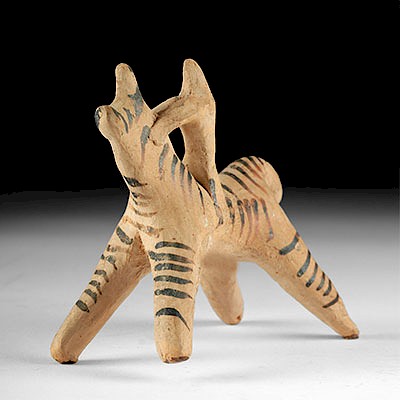Egyptian Amarna Acorn-Shaped Pottery Jar - TL'd
Lot 2b
About Seller
Artemis Fine Arts
686 S Taylor Ave, Ste 106
Louisville, CO 80027
United States
Selling antiquities, ancient and ethnographic art online since 1993, Artemis Gallery specializes in Classical Antiquities (Egyptian, Greek, Roman, Near Eastern), Asian, Pre-Columbian, African / Tribal / Oceanographic art. Our extensive inventory includes pottery, stone, metal, wood, glass and textil...Read more
Estimate:
$2,000 - $3,000
Absentee vs Live bid
Two ways to bid:
- Leave a max absentee bid and the platform will bid on your behalf up to your maximum bid during the live auction.
- Bid live during the auction and your bids will be submitted real-time to the auctioneer.
Bid Increments
| Price | Bid Increment |
|---|---|
| $0 | $25 |
| $300 | $50 |
| $1,000 | $100 |
| $2,000 | $250 |
| $5,000 | $500 |
| $10,000 | $1,000 |
| $20,000 | $2,500 |
| $50,000 | $5,000 |
| $100,000 | $10,000 |
| $200,000 | $20,000 |
About Auction
By Artemis Fine Arts
Oct 25, 2018
Set Reminder
2018-10-25 11:00:00
2018-10-25 11:00:00
America/New_York
Bidsquare
Bidsquare : Antiquities from Egypt, Greece, Italy, Asia
https://www.bidsquare.com/auctions/artemis-gallery/antiquities-from-egypt-greece-italy-asia-3538
Featuring Egyptian, Greek, Roman, Etruscan, Near Eastern, plus Asian art from Central and Far East. If you love the classics, this is the sale for you. Artemis Fine Arts info@artemisfinearts.com
Featuring Egyptian, Greek, Roman, Etruscan, Near Eastern, plus Asian art from Central and Far East. If you love the classics, this is the sale for you. Artemis Fine Arts info@artemisfinearts.com
- Lot Description
Ancient Egypt, New Kingdom, 18th Dynasty, Amarna Period, reign of Akhenaten, ca. 1352 to 1336 BCE. A lovely acorn-shaped vessel with twin loop handles on the shoulders, a short cylindrical neck, and flared rolled rim. The exterior walls are decorated with a motif of lotus or palmette leaves in red and blue-green with black outlines. Similar motifs appear on the Amarna-period tomb-chapel of Nebamun which depicts the wealthy official and his wife in the marshes along the banks of the Nile with naturalistic fauna and flora. Scholars have noted that the depiction of lotus motifs may suggest that the wine or liquids contained by these vessels were infused with lotus. Size: 4.625" H (11.7 cm); 5.125" H (13 cm) on included custom stand.
According to the curatorial team of the Metropolitan Museum of Art, "The use of predominantly blue floral motifs in the decoration of terracotta vessels reached its peak during the reigns of Amenhotep III and Akhenaten.The principal component of the blue pigment that was applied to ceramic vessels before firing was cobalt. Numerous examples of ceramics decorated in this style were excavated by the Museum in the palace of Amenhotep III at Malkata, in Thebes (for example 11.251.460) - https://www.metmuseum.org/art/collection/search/546069.
According to the Egypt Centre of Swansea University, "Blue painted pottery is sometimes called 'Malqata wear' from the place where it was first found. Arnold and Bourriau (1993, 100) suggest the blue painted wares originated in Memphis. Such pottery generally dates from the mid 18th the late 20th Dynasty. Blue painted ware seems only to have been made at royal residences or palaces and apparently by a small number of craftsmen in a few workshops. However, see Bourriau et al. (2000, 140) which states that at Amarna blue painted pottery was also found in poorer areas. The main difference in pottery between rich and poor areas appears to be in the quality of decoration. It was used in the house, in religious activities and in tombs and traded in its own right rather than as a container."
They continue, "It is believed that such pots were decorated before firing. The blue paint is cobalt blue. Red and black derived from oxides of iron (ochre) and manganese. Cobalt may have derived from the deposits of alum which occur in the Kharga and Dakhleh oasis. The decorative elements appear to imitate floral garlands which were placed around vessels (Freed et al. 1982, 38). Some (though we have none in the Centre) also show animals or gods such as Bes. The garlands, it has been suggested, were perhaps to cool or maybe simply provided an aesthetic experience. It has also been suggested that the predominance of the lotus may be related to the possibility that wine contained within such vessels was infused with lotus. Other floral motifs show the white lotus, the cornflower, poppy, mandrake and chrysanthemum (Freed et al. 1982, 38)." (http://www.egypt.swan.ac.uk/the-collection-2/the-collection/amarna/amarna-pottery/)
This piece has been tested using thermoluminescence (TL) and has been found to be ancient and of the period stated. A full report will accompany purchase.
Provenance: private East Coast, USA collection
All items legal to buy/sell under U.S. Statute covering cultural patrimony Code 2600, CHAPTER 14, and are guaranteed to be as described or your money back.
A Certificate of Authenticity will accompany all winning bids.
We ship worldwide and handle all shipping in-house for your convenience.
#135539Expected surface wear and old abrasions/loss to lower pointed end, but rare to find an example that is in such good condition, and there are nice remains of the colorful decorative program.Condition
- Shipping Info
-
All shipping is handled in-house for your convenience. Your invoice from Artemis Gallery will include shipping calculation instructions. If in doubt, please inquire BEFORE bidding for estimated shipping costs for individual items.
-
- Buyer's Premium



 EUR
EUR CAD
CAD AUD
AUD GBP
GBP MXN
MXN HKD
HKD CNY
CNY MYR
MYR SEK
SEK SGD
SGD CHF
CHF THB
THB














